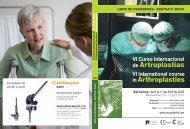cadera / hip - Active Congress.......
cadera / hip - Active Congress.......
cadera / hip - Active Congress.......
Create successful ePaper yourself
Turn your PDF publications into a flip-book with our unique Google optimized e-Paper software.
MIÉRCOLES / WEDNESDAY<br />
102<br />
ing system (Table 1) with a score >3 representing<br />
a 12 fold increase risk in early failure<br />
or adverse radiological changes. In addition,<br />
when Amstutz and associates25 reported on<br />
the overall experience in the fi rst 400 hybrid<br />
metal on metal SA, a SARI >3 had a survivors<strong>hip</strong><br />
of 89% at four years versus 97% with a<br />
score < 3.<br />
Currently, the posterior approach is the most<br />
commonly used for <strong>hip</strong> resurfacing. However,<br />
as discussed in this issue by Nork and associates30<br />
the choice of a surgical approach<br />
for <strong>hip</strong> resurfacing must factor in different<br />
anatomical considerations than when performing<br />
a standard total <strong>hip</strong> replacement.<br />
With preservation of the femoral head and<br />
neck, issues such as vascularity and adequate<br />
visualization with minimal trauma to<br />
tissues and nerves must be considered10,30 .<br />
For example, the choice of a surgical approach<br />
compromising femoral head blood<br />
supply10,30,31 and causing osteonecrosis could<br />
lead to femoral loosening32 or femoral neck<br />
fracture33 if the lesion is suffi ciently large. In<br />
addition, because of its conservative nature<br />
and goal to closely reproduce the normal<br />
anatomy of the proximal femur positioning of<br />
the implants may have a greater impact on<br />
implant survivors<strong>hip</strong> and patient function than<br />
with a standard <strong>hip</strong> replacement.<br />
In the 1982 OCNA issue on surface arthroplasty,<br />
Hedley31 emphasized the importance<br />
of maintaining femoral head vascularity when<br />
considering intervention in early stages of arthritis<br />
whilst in the more advanced stages an<br />
intramedullary source would be suffi cient34 .<br />
The discussion at that time was not so much<br />
what surgical approach to use since most<br />
were using a pure anterior35 or extracapsular<br />
trochanteric osteotomy36 but can one safely<br />
dislocate the native <strong>hip</strong> joint without causing<br />
osteonecrosis. Subsequent retrieval analysis<br />
papers of failed surface arthroplasty failed to<br />
identify any major osteonecrotic segments. 37-<br />
39 , however the massive granulomatous<br />
reaction from the polyethylene wear debris<br />
combined with bone resorption secondary<br />
to implant micromotion did not leave much of<br />
the bone at the implant interface intact. And<br />
more importantly, most surgeons at that time<br />
where performing <strong>hip</strong> resurfacing through<br />
approaches which left the obturator externus<br />
tendon intact protecting the branch of the medial<br />
circumfl ex artery 40 . In addition, there is<br />
recent evidence that the blood supply pattern<br />
in advanced arthritis is not signifi cantly different<br />
than in the non arthritic state 41 . Recent<br />
work on arthritic femoral heads, presented<br />
at the annual Orthopaedic Research Society<br />
meeting in Washington, DC (February 2005)<br />
demonstrated using laser doppler fl owmetry<br />
that damage to the extraosseous blood supply<br />
to the femoral head (retinacular vessels)<br />
can cause a signifi cant decrease (greater<br />
than 50%) in blood fl ow. Further followup and<br />
research will be required before we can fully<br />
assess the role of femoral head vascularity<br />
on the clinical outcome of <strong>hip</strong> resurfacing,<br />
however the choice of a surgical approach<br />
which minimizes the risk of damaging the<br />
blood supply to the femoral head need to<br />
be strongly considered. This may become<br />
even more crucial as we consider cementless<br />
fi xation on the femoral side and earlier<br />
intervention in the arthritic process to avoid<br />
the development of femoral head cysts.<br />
Finally, one must consider the underlying diagnosis<br />
when evaluating a patient for surface<br />
arthroplasty. In cases of dysplasia, acetabular<br />
defi ciencies combined with the inability<br />
of inserting screws through the acetabular<br />
component may make initial implant stability<br />
unpredictable. This deformity in combination<br />
with a signifi cant leg length discrepancy or<br />
valgus femoral neck could compromise the<br />
functional results of surface arthroplasty, and<br />
in those situations a stem type total <strong>hip</strong> replacement<br />
may provide a superior functional<br />
outcome 51 . Finally, the presence of a metal on<br />
metal bearing leads to an increase in metal<br />
ion release 9,52 . Consequently, because the<br />
information on the systemic distribution of<br />
metal ions and their interaction with living<br />
cells is limited, patients with compromised<br />
renal function and a history of metal sensitivity<br />
are probably not good candidates for a





